
Of everything I've read, played, or watched over the years, Higurashi no Naku Koro ni is probably the one most inextricably linked to a real world location in my mind. Any fan of the series has most likely run across the trivia that Hinamizawa, the primary setting of Higurashi, is based off of the real life village of Shirakawa-go. Plenty of stories take advantage of their settings to provide memorable set pieces, but Higurashi stands out for featuring such a remote location. I had absolutely no preconceived notions about Shirakawa-go when I first watched the Higurashi anime in my teens or read the visual novels as they were released on Steam several years back. To me, it was an isolated village, noteworthy only for its connection to the horror series.
Over the years, I've learned this simply isn't true. Shirakawa-go was declared a UNESCO World Heritage Site in 1995, a status which has drastically increased tourism to the area. Long before the release of part one of Higurashi in 2002, Shirakawa-go received over one million tourists just one year after receiving the title. While the total number of tourists per year has doubled since then, this seems to correlate more with the opening of an expressway making the village significantly more accessible in 2008 and Japan's ever-increasing number of tourists.1 There are undoubtedly people who make a pilgrimage to the village to see the inspiration for Hinamizawa, but they represent a very small percentage of overall visitors.
Despite its popularity for other reasons, Shirakawa-go still sticks out in my mind as the one "holy site" in Japan that I would be particularly interested in visiting. I'm not sure there's any series I have a strong enough connection to that seeing a featured bench or set of stairs would feel very fulfilling. During my last trip, I went to Sunshine City to see some of the locations featured in BanG Dream: It's MyGO!!!!!, only to find that, well, it looked a lot like any other mall in Japan. I didn't feel the connection I thought I would. Shirakawa-go, however, is different enough from anywhere else that it would be a special experience even without its relation to Higurashi. Shirakawa-go is recognized as one of the most beautiful areas in Japan. Just maybe, that beauty might contribute some to the "sacred" feeling I was hoping to experience at a holy site.
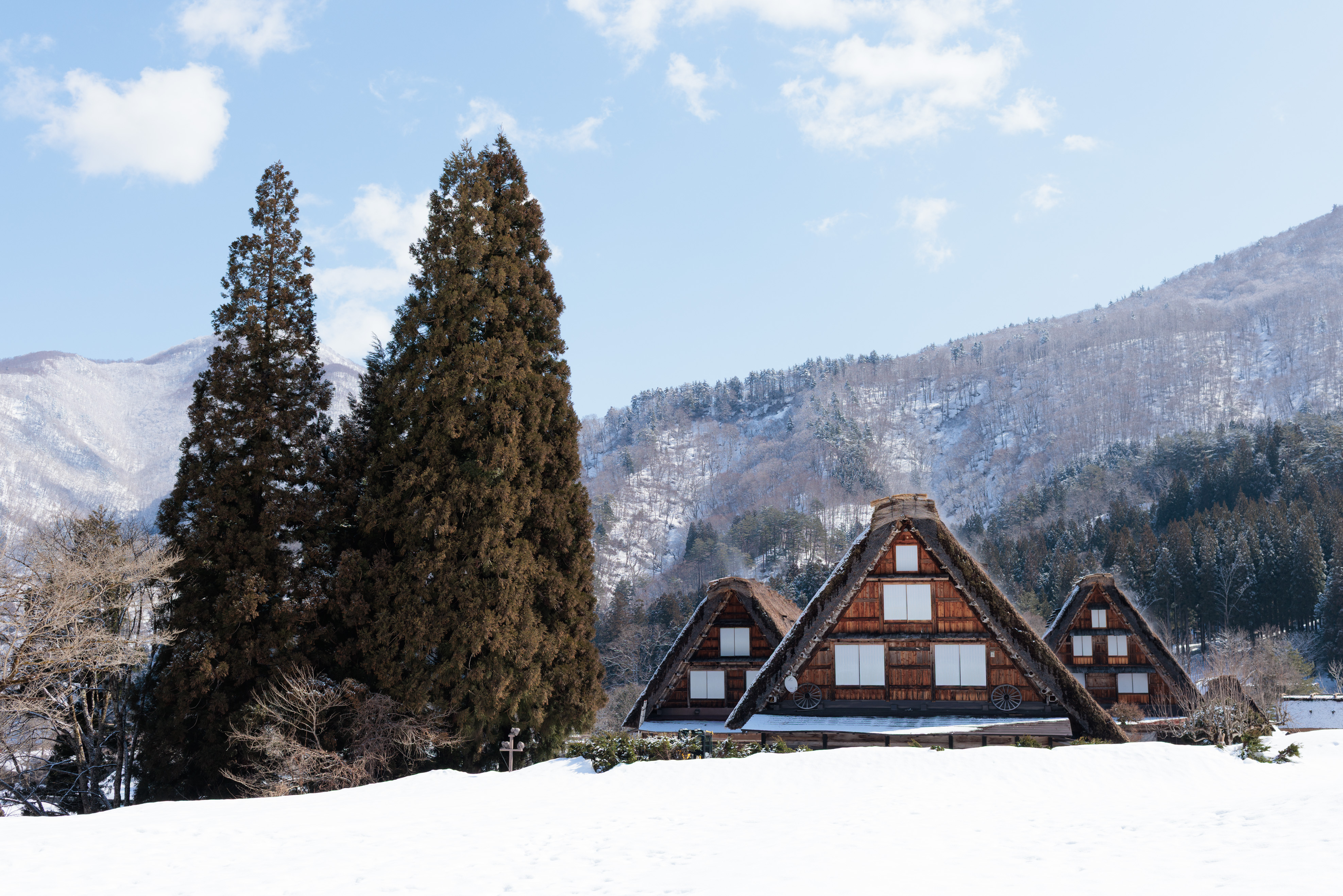
The famous Shirakawa-go three houses
In March of this year, I decided to include Shirakawa-go on my itinerary for my second visit to Japan. I would take the train from Osaka to another tourism hotspot, Takayama, and then ride the bus from Takayama to Shirakawa-go in the morning. I debated whether or not to spend a full day in the village. I read conflicting accounts online, with some saying only a few hours are required to take in the scenery, others passionate that an overnight stay in one of the area's Gassho-style homes was the highlight of their trip. Primarily interested in the sights rather than the traditional inn experience, I opted for the former option.
After a harrowing night in Takayama involving a drainage gutter, I boarded the second earliest bus to Shirakawa-go the next morning. This got me there around 8:40, which would later prove to be a great choice. Shirakawa is actually divided into two parts, with the majority of its population living in the northern half, and Shirakawa-go, the portion of town that houses the preserved village with Gassho-style homes, occupies the southern half. The Shirakawa-go Bus Terminal sits just north of the division to allow easy access to the preserved village, making it pretty clear that tourists aren't expected to journey into the other parts of town. There are also additional parking lots circling around the outskirts of the area.
I only had a few hours until my departing bus, so I got straight to exploring. The first thing to strike me was just how much snow was still left in the village. I figured by late March it would have completely melted, especially since nearby Takayama showed few traces of accumulated precipitation outside of its more forested areas. The streets were clear, but massive snow banks sat just about everywhere else. Many of the traditional houses were still dusted, with signs warning that snow will fall from their triangular roofs. The weather was well above freezing that day, but the snow banks looked like they would hold out for at least a few more weeks.
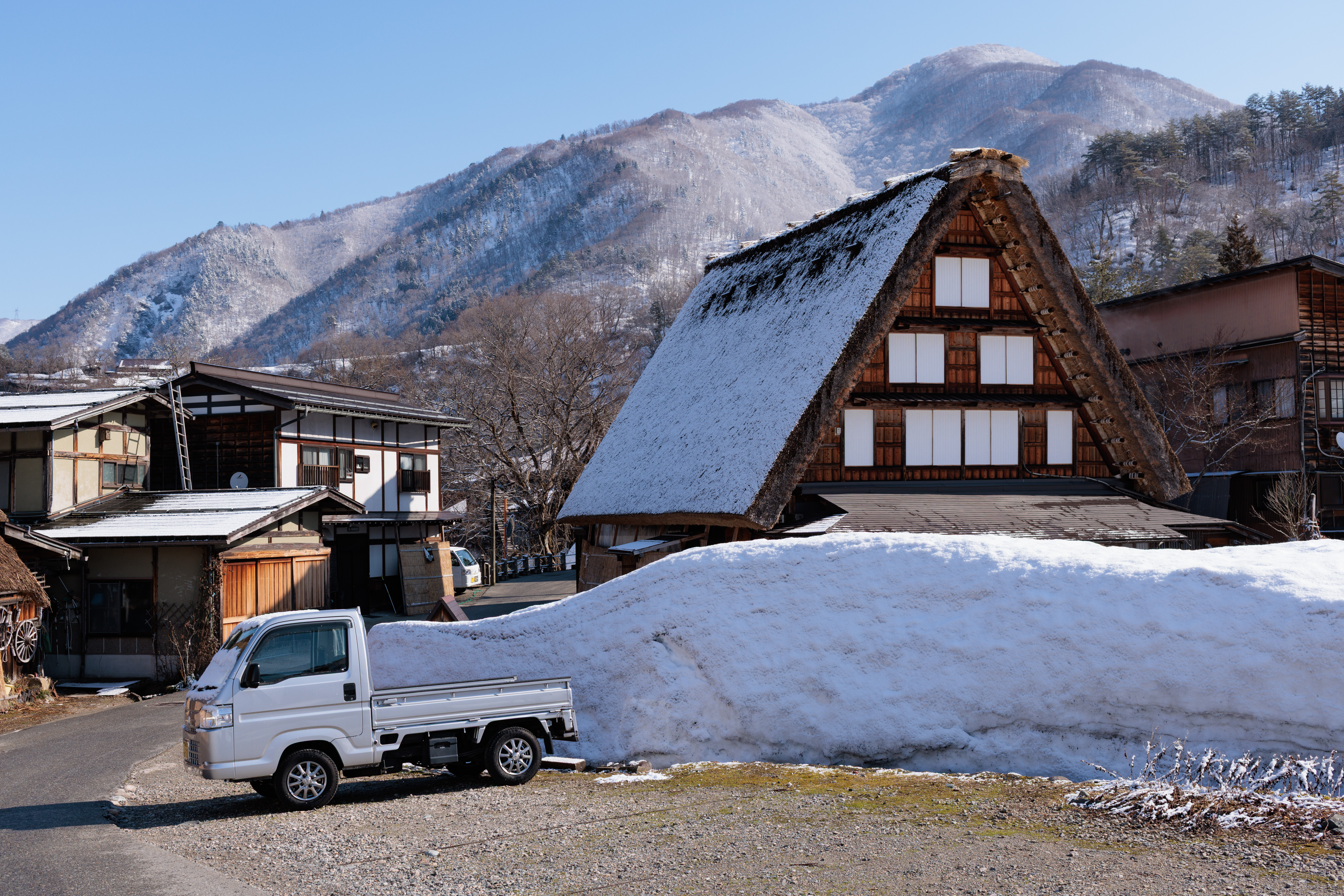
I did not expect so much snow to be leftover as the seasons changed
I wandered aimlessly for a bit, before pulling up Google Maps. One handy feature of the platform (that will inevitably be killed off to save 3 cents each day) is the ability for users to create and share custom maps with locations marked with custom descriptions and images. In preparation for the trip, I added a "Higurashi Real Life Locations" map created by Reddit user LankySeat. Opening the map showed I was quite close to one of the three "Higurashi shrines" in the area. The three primary gift shops that offer a selection of Higurashi goods each have one of these "shrines," prominently featuring figures, posters, and various other memorabilia of the series. Surprisingly, the shop was already open. Very few businesses in Japan seem to open before 10, but perhaps due to Shirakawa-go's unique problem of tourists trying to enter every traditional building they see, some stores decided they might as well open early.
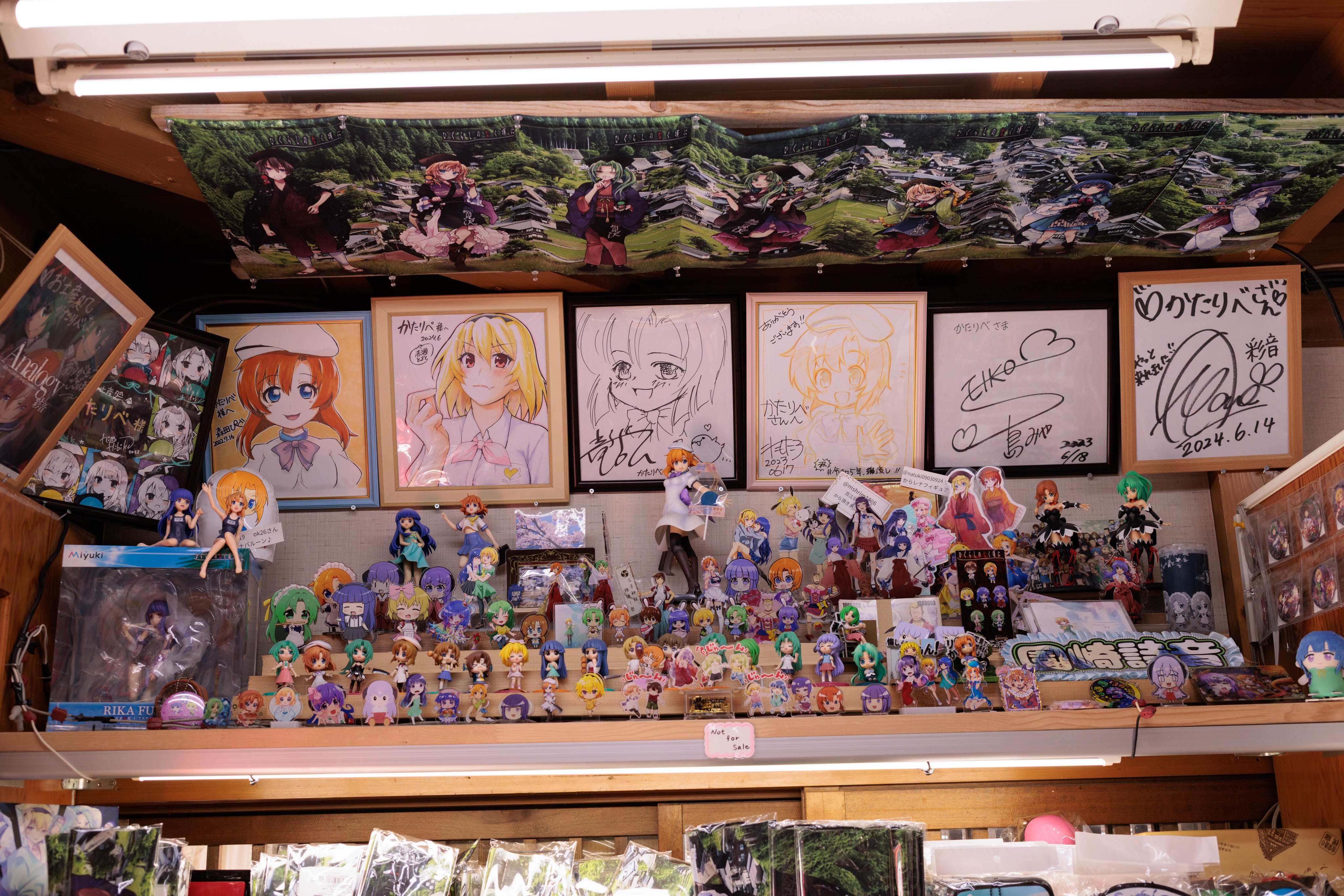
The first of the Higurashi shrines I encountered
Despite the shop's dedication to Higurashi, merch for the franchise really only occupied the shelving area underneath the shrine, further evidence that otaku pilgrimages make up a very small percentage of tourists. A bit let down at the selection but nonetheless excited to get some exclusive commemorative merch, I picked up a large Shion standee, supposedly only for available for purchase in the town, and a couple of gifts for friends. After paying, the clerk (likely the shop's owner) offered me a map marking the real world equivalents of locations from the series. This was a professionally printed pamphlet with art from the recent anime, and the front cover declared it to be a collaboration between the franchise and the Shirakawa-go tourism board. The map would make a nice souvenir, but the one I downloaded provided many more locations and good ol' reliable GPS to keep track of my relative location to any other sights.
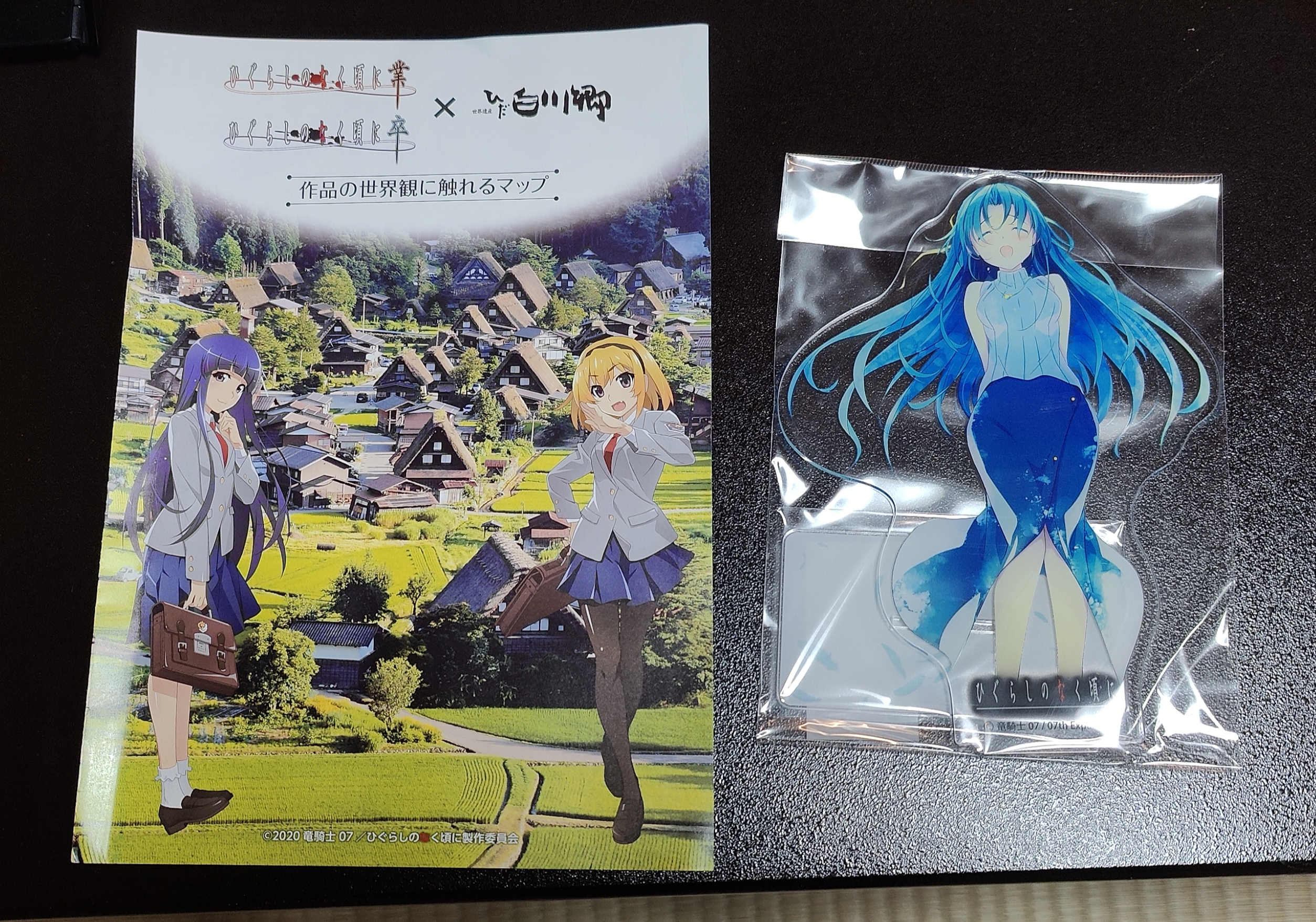
The front page of the map I was given, along with the large Shion standee I purchased
I walked over to the Shirakawa Hachiman shrine next, a location photographed to serve as Furude Shrine in the visual novels. If not for the torii, I could have easily mistaken it for a similar, unrelated shrine. Snow and ice completely enveloped the stairs leading up to the shrine's main hall, and the main hall itself was modestly covered up by curtains, presumably to protect it from the elements. Nearly falling onto my face several times, I made my way up the icy slope to get a closer look. This was probably the location I was most looking forward to seeing, recalling the image of hundreds of lovingly drawn Higurashi characters on ema (wooden plaques offered for prayer) hanging in front of the shrine I'd seen years before. Unfortunately, the hall was closed up tight, and I was unable to find any traces of the ema. A bit disappointed, I slid my way down the hill and decided where I should head next.
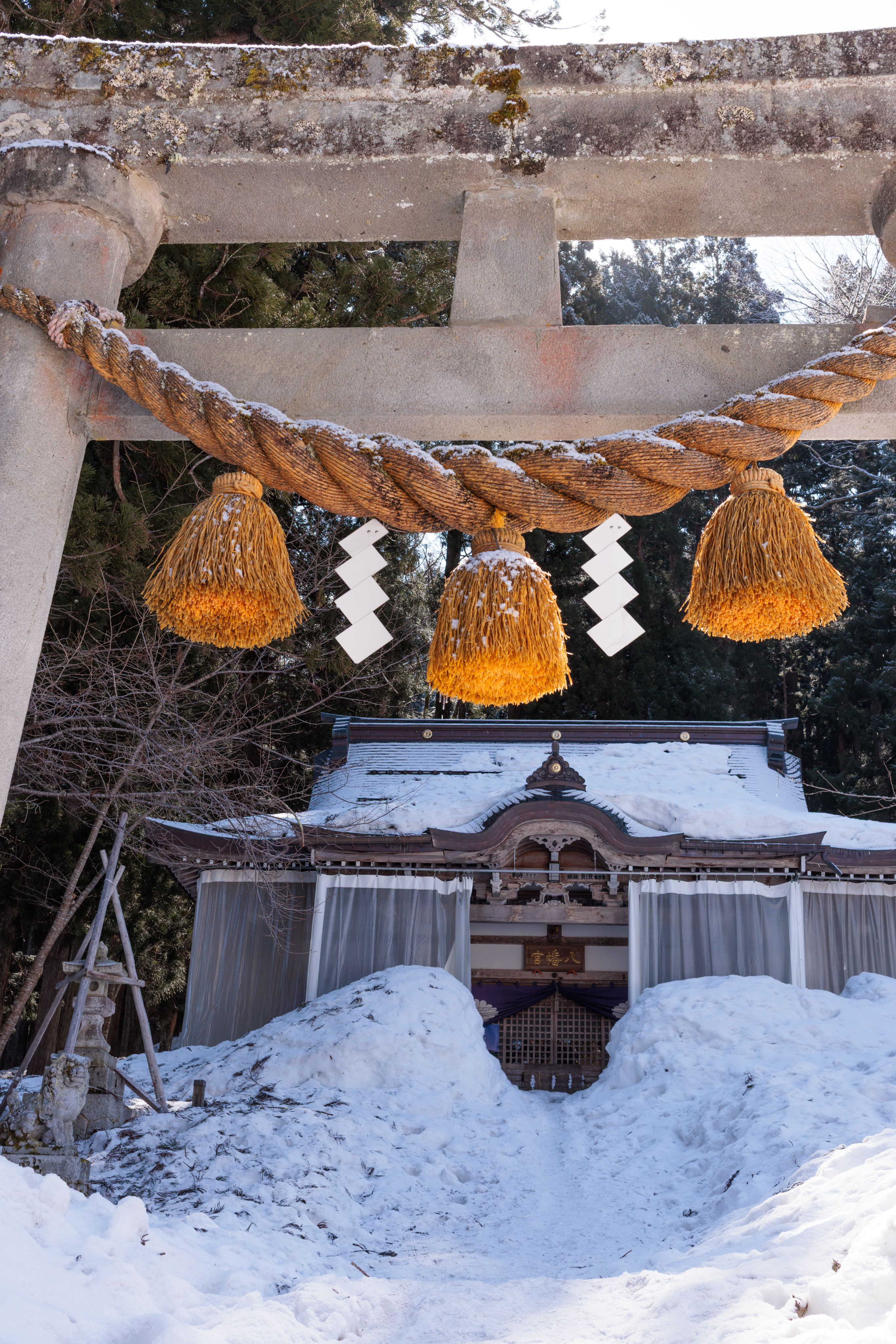
Shirakawa Hachiman shrine, now with modesty curtains
I decided to put my phone away for now and simply appreciate the preserved village for what it was. Honestly, it's a beautiful place. I was afraid it would be harder to appreciate what I was seeing having visited Hida Folk Village in Takayama the day before. Hida Folk Village features houses in the same Gassho construction, but it exists as an artificial ghost town consisting of several buildings relocated to approximately represent a traditional village. No one except tourists walk its dirt pathways. It's an area completely shut off from time, unless one enters the vending machine filled rest area or one of several modern bathrooms on the premises. It serves its purpose as an open air museum, demonstrating the ways of life of days gone by. It's beautiful in its own right, but it's a very different place from Shirakawa-go.
In comparison, what made Shirakawa-go so fascinating to me was the juxtaposition of the old and the new. Existing around the preserved homes and droves of tourists, people are living their lives. The streets are paved so that the residents can take their cars in and out (visitors, fortunately, are not allowed to drive through). Many of the traditional buildings now house gift shops and inns, but many more are private residences. Just a stone's throw away, an entire small town attempts to survive, with little to subsist on outside of its tourism draw. I saw a group of skilled workers replacing the thatch roofing of one of the Gassho-style homes, doing their best to ignore the occasional person stopping to take a picture of their handiwork. Shirakawa-go exists in and out of time, attempting to preserve its historical value while desperately trying to hold onto what remains of its slipping population. Thousands descend upon the town each morning, only for most to leave by 5pm the same day, when tourists must exit the area unless they are staying the night.
Speaking of thousands descending, I realized I should probably plan what I wanted to see before the majority of them arrived. Looking at my map again, I opted to pass by a few more Higurashi landmarks on my way over to the Ogimachi Castle Observation Deck. I saw the Hojo family's house, the small house Satoko and Rika occupied, and a few shots featured in the anime openings. The Hojo house was the most interesting to me. I walked up to a yellow house, unusual for the area, and I was sure I'd found it. I snapped a few pics to share later and moved on. It was only after the trip, doing some reading for this post, that I realized: in the original visual novel, the Hojo house is a natural wood color. Only in the successive remakes did the house change to be yellow. Was this to reflect the real changes that occurred in the village since the original was released? As it turns out, no. The original Hojo house neighbors the yellow house I took some shots of, and the remakes seemingly combined elements of both houses. The structure of the building is mostly the same, but the color has been changed to yellow. Strange.

Top left: The original Hojo home in the game. Top right: The Hojo home featured in the PS3 remake of the game. Bottom left: The Hojo home in real life2. Bottom right: The house I mistook for the Hojo home.
The path up to the observation deck was surprisingly steep, with the ice formed overnight by traces of snowmelt providing some real danger in the morning shade. I completed the ascent without incident, and I saw the first cluster of tourists since I got off the bus. There weren't a ton, but people were happily taking selfies or offering borrowed cell phone portraits to families. The observation deck wasn't so much a deck but a curve at the top of the hill where people could stand. I took a few token shots overlooking the village, but what I really wanted to see was a little further up the road. A second overlook neighbored another gift shop with Higurashi merch, a cafe with some Higurashi themed items, and supposedly, the other location in town with Higurashi ema. It turns out the second observation deck was blocked off for paid portraits only, causing the area next to it to be quite crowded with various lines and people milling about. I didn't see the ema anywhere, and the number of lines had me flustered, so I quickly scanned the nearby gachapon machines and then headed back down.
At this point, I was getting a little bummed. The sights were definitely beautiful, breathtaking even. But at the same time, I felt like I was missing out on a lot of the small, dorky things I wanted to see. I failed to find a path to the suspension bridge that wasn't blocked off, which prevented me from seeing the site of the Wataganashi cotton floating rituals. It's been ages since I've seen the anime, so the points on my map denoting additional pathways and homes featured in it weren't doing much for me either. Losing energy fast, I realized I needed a sweet treat to perk me back up. I caught a glimpse of a cafe specializing in baumkuchen off the main drag of gift shops and other tourist draws. After some debate, I entered.
The warmth of the store, named Egaoya Cafe, immediately welcomed me. Inside, there were a handful of wooden tables and chairs cushioned with faux sheepskin. Only one woman was working that day, but according to the cafe's Instagram, two sisters run the shop together. While waiting for my turn to order, I spotted two shikishi boards of cute Higurashi artwork on the wall. On further inspection, one definitely looked like the artstyle of Ryukishi07, the primary creator of the series. Once the pair in front of me finished ordering, I asked if it was okay to take a picture. She kindly agreed and even brought them over to the counter for me. Sure enough, one of the boards was drawn and signed by Ryukishi, who complimented the baumkuchen. I didn't recognize the signature or style of the other piece, but my friends later figured out it was drawn by Remotaro, who's done some sprite coloring on later 07th Expansion projects. Egaoya only opened in September of 2024, so the art must have been from a fairly recent visit.
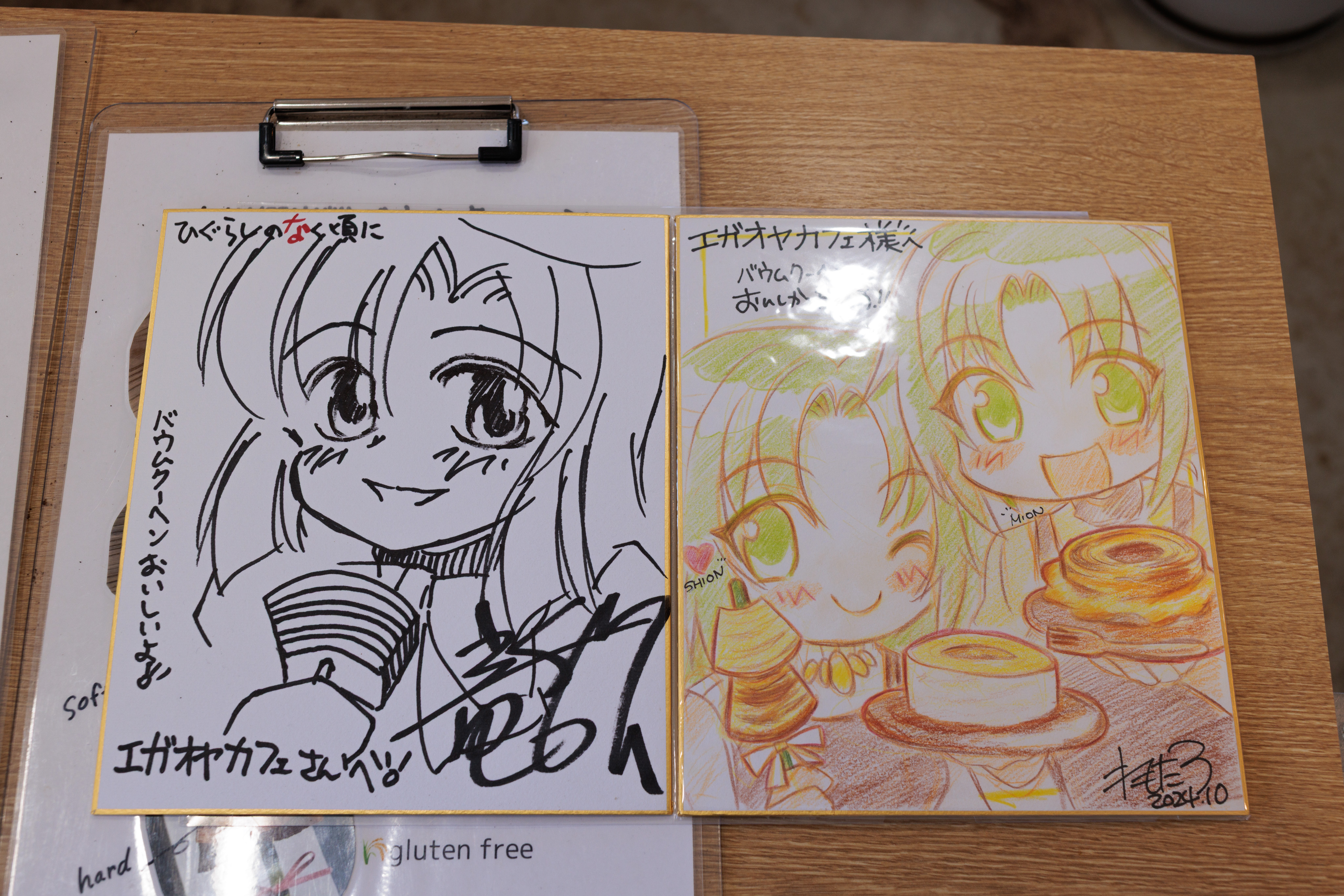
The shikishi drawn by Ryukishi07 and Remotaro. The Ryukishi shikishi compliments the baumkuchen.
I ordered a latte and baumkuchen (a whole ass baumkuchen by the way, not one of the cowardly "baumkuchen on a stick" options) and sat down against the wall. Even before getting my cake and coffee, I was already doing a lot better. Accidentally running across that art where I least expected made it feel special. A few people were in line at the cafe's counter now, and I overheard a couple discussing what I had taken a picture of ("What's that?" "Something from an anime, I guess"). After a few minutes, my snack had arrived. I'd never eaten baumkuchen before, but it was delicious. I chose the soft variety over the crunchy one. The sweetness and density were just right, with a light sugar glaze around the outside giving some extra texture. The sliced cake with toothpicks was clearly intended to be shared by two or three people, but you shouldn't underestimate my propensity for overindulgence. The latte was pretty good too. Espresso drinks aren't quite as ubiquitous in Japan, so running across a particularly tasty one is always a happy occasion.
Reinvigorated, I switched over to my film camera and decided to get some more pictures of the Gassho village. By the time I'd finished my snack, the town was fully swarmed with tourists. Countless individuals and families were wandering about. Stranger to me were the classic Chinese tour groups: a guide with a flag in hand and a long, snaking line of people in tow. I'm really not sure what a guide could offer in an area fully traversable by foot in an hour or two that would outweigh a suffocatingly rigid itinerary, but countless people seemed to believe this was the proper way to get around. Shirakawa-go was a beautiful, quiet place in the morning, where I could really start to appreciate the contrasting simplicity and complexity that comes with living in a world heritage site. By late morning, the simplicities were gone. Now it just seemed like an unpleasant place to live. I wouldn't be able to handle hundreds, thousands of people on my doorstep each day.
There were far too many people for me to get any satisfying wide shots, so instead, I weighed my two options for the hour I had left here: search again for the ema at the shrine and observation deck or make my way across town to see the Furude family residence, Maebara family home, and shrine storehouse. These were all past the core of Shirakawa proper and near the northern outskirts. I really love wandering around small towns in Japan, so I was definitely interested in making the two or three kilometer walk over. But the ema were stuck in my head as something I thought I had to see, and I'd already walked for several hours around Uji, Nara, and Takayama in the last week. So, I approached the ascent to the observation deck once more and began my trudge. The sun was shining down now, making the partially thawed ice even slipperier.
Once again reaching the gift shop area, I realized there was really only one place the ema could be, in the narrow covered space between the gachapon machines and gift shop outer wall. And sure enough, there they were, up against a wall most people would never look at. They had been directly behind me when I'd checked out the gacha options earlier! The plaques varied widely, most in Japanese, some in English and other languages. Quite a few wishes were written on ema pre-printed with Higurashi designs or left with text only, but plenty still had hand-drawn pieces in a number of styles. I don't know the manners regarding ema, anime related or not, so I examined them for a bit without touching or flipping through them, took a few pictures, and left to allow someone else to check them out. I was only there for half a minute or so, but I still felt satisfied in finding them.
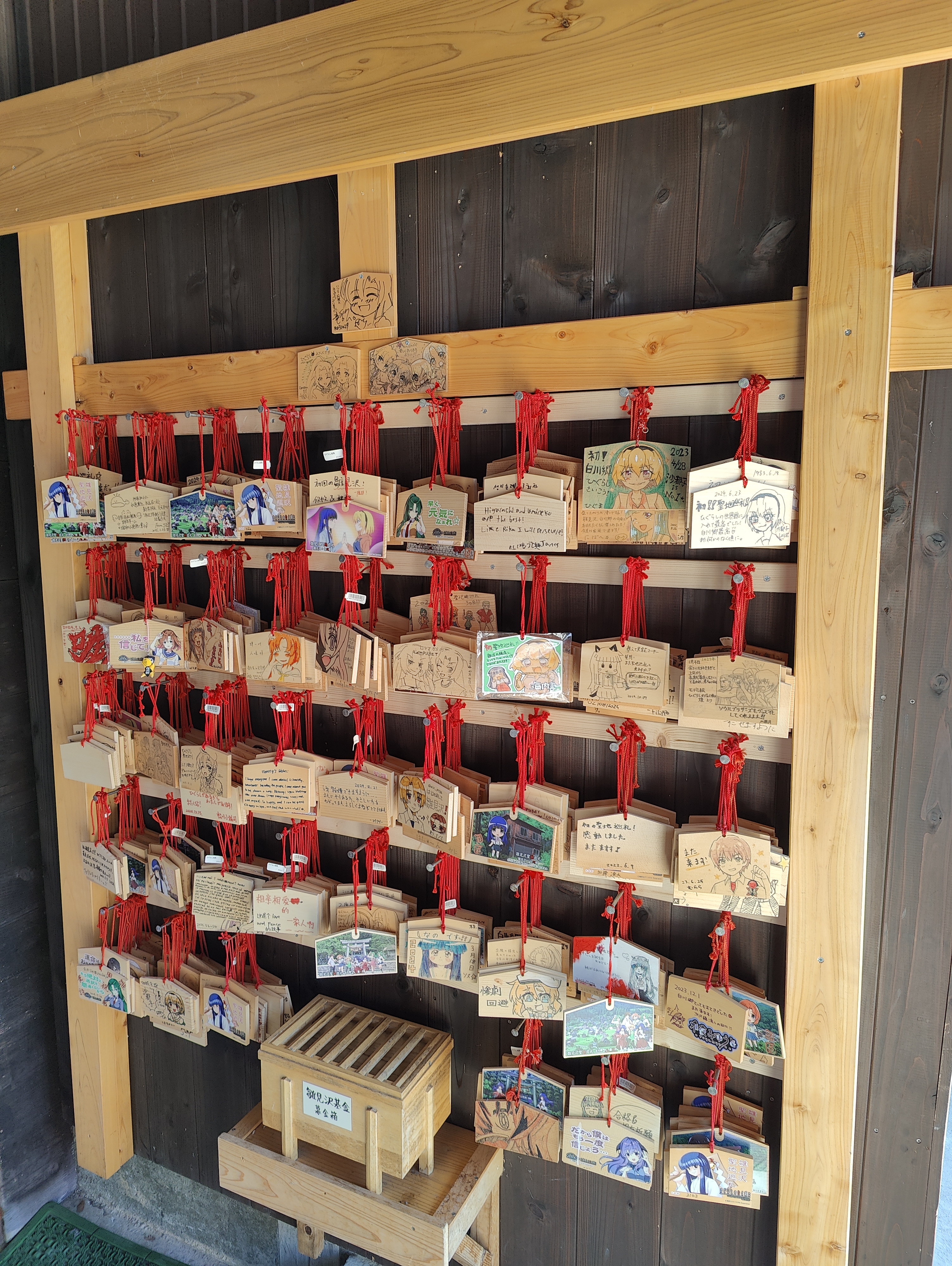
At last, the Higurashi ema. Why did I only take a picture with my phone camera? I am stupid.
I entered the gift shop to see if there were any Higurashi items that weren't present at the one I stopped at in the morning. The section dedicated to the series in this store was a little bit larger, but just like the earlier shop and the ena, it was tucked into a far corner as if to not bother the more typical tourists. This shrine was a bit more extravagant, featuring cardboard cutouts, handdrawn ena, and other pieces of art signed or drawn by a number of people involved with the series. I found some t-shirts that the first store didn't have, but the selection was pretty similar otherwise. With the clock ticking, I left and started down the hill.
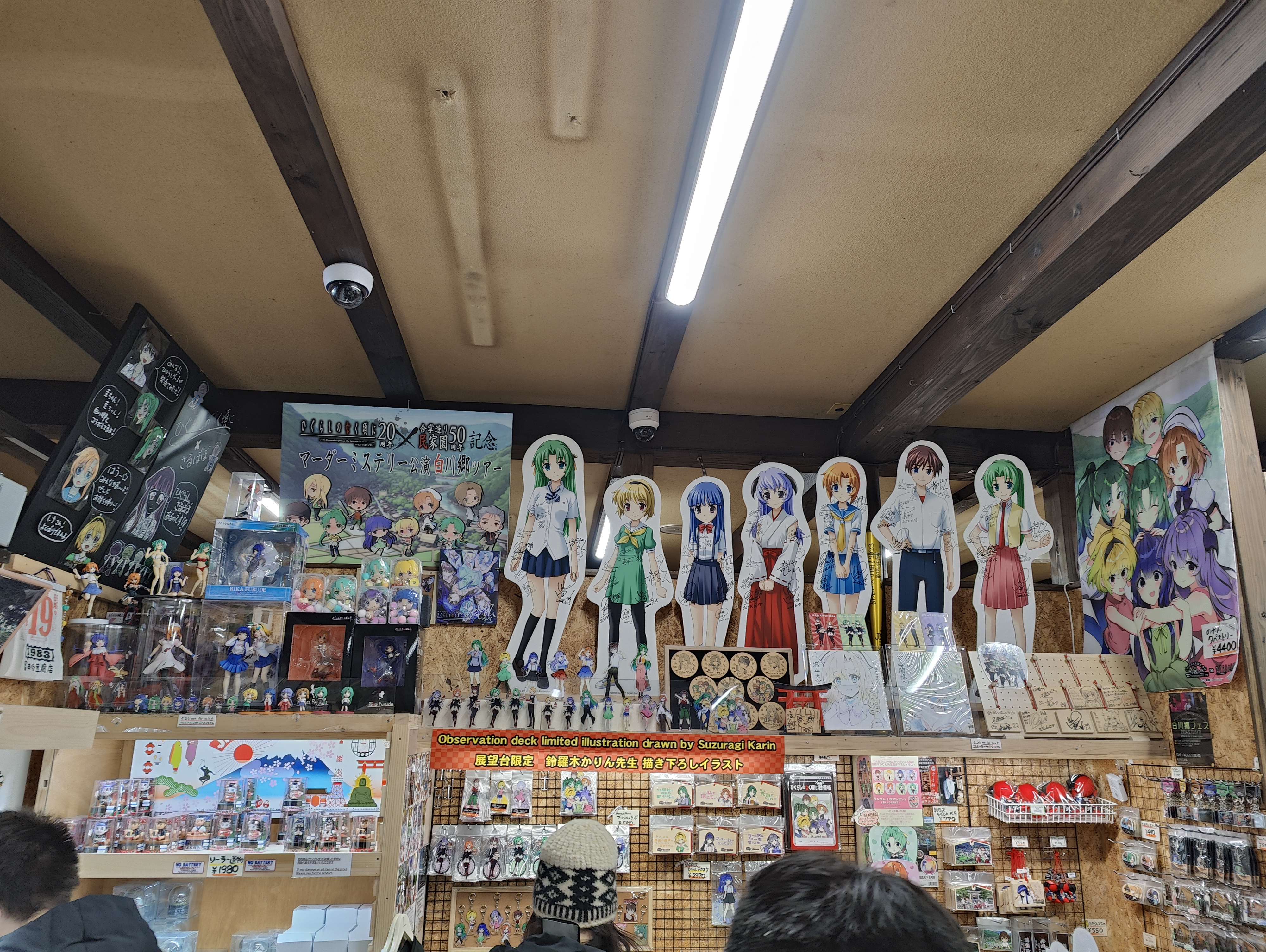
The second shrine
As mentioned earlier, some parts of the steep hill were now slick. I saw one person fall who was quickly caught by family members on either side of him in dramatic fashion before he could even hit the ground. Smirking a bit at the scene, I hurried down past them. Less than 30 seconds later, I slipped right onto my ass. Karma or Oyashiro-sama, I guess. Checking out the snow covered shrine for a second time, I slipped and fell on my ass for a second time. Once again unable to find any ena there, I slipped and fell on my ass for a third time on the way down.
Sights properly seen and ass properly fell on, it was time for me to head to the bus station and board my bus. The ride to Kanazawa was a little bizarre, with seemingly half of the route covered by multiple tunnels several times longer than any I'd experienced on roads before. Here's probably where many people would say they reflected on their journey, but buses put me straight to sleep. I didn't stop and process how I felt about Shirakawa-go until my plane ride home a week later.
First, I want to be clear that Shirakawa-go is a stunning place that I would absolutely recommend adding to a trip itinerary if your travels put you in Gifu or Ishikawa prefectures. Despite some of my conflicted feelings and small disappointments, this was one of the most memorable days of my trip. If you plan on visiting, I believe arriving first thing in the morning or staying overnight is the way to go. The hordes of tourists that arrive late morning and swarm around until their forced departure at 5pm quickly overpower the serene atmosphere of the village, replacing the clean air and fantasies of a simpler life with the noisy hustle and bustle of any other major tourist attraction. Making the trip in the summer or fall might also be preferable if you’d like to see everything unimpeded by huge snowbanks.
What made my trip feel rather strange is how severely steeped in contradiction Shirakawa-go feels. On average, over 2,000 people visit each day, but fewer than 2,000 people live there. With an aging population and strict local laws around how the Gassho style homes can be used, everyone wants to visit, but no one wants to stay. Furthermore, UNESCO heritage sites exist to conserve unique areas of significant value, but it is often this very status that drives up tourism to unsustainable amounts and threatens the heritage and beauty they wish to preserve.
At a smaller scale, the village's relationship with Higurashi holds similar contradictions. Maps produced as a collaboration between Shirakawa's tourism board and 07th Expansion suggest the town has a healthy relationship with those making pilgrimages for the series, but the reality seems a bit muddier. Probably due to the intense number of tourists the village already receives, the acceptance of this particular heritage feels begrudging at best. There were no indications of Higurashi on public property, only in shops where the owners give the occasional nod. It exists as an easter egg within the confines of Shirakawa-go, free for fans to scout out, but only if they don't get in the way of anyone else. Unlike many other holy sites in Japan, Shirakawa-go doesn't need Higurashi to drive tourism, so they don't embrace it.
Despite these disappointments, I did actually walk away with a positive feeling. This is in large thanks to the baumkuchen shop, which reminded me that acceptance from entities like the local government or public majority are optional. It may be unseen by most, but Ryukishi07 and the rest of 07th Expansion have left an undeniable mark on the area. Those who want to see this influence will find it. It reminded me that art doesn't need to appease the greater public; as long as it touches somebody, it will leave an impact in the world. It feels a bit silly for me to come to this conclusion based on what is now a heavily merchandised franchise with countless fans, but it is a series that began as a modest work made by a few people with passion and a vision that they pursued despite a lack of perfect artistic skill. Fuck the haters and fuck AI. Make what you want to with what you have. Collaborate with your friends to make up for your own shortcomings. Create art! Explore the world! Tongue kiss a tree! Enjoy what you can and leave behind something meaningful. Thanks for reading.
1 Based on information from Shirakawa village's official website here.
2 Image taken from Reddit post by user qwcan